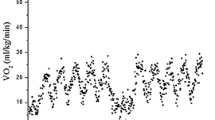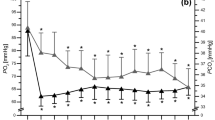Abstract
To determine which active-recovery protocol would reduce faster the high blood H+ and lactate concentrations produced by repeated bouts of high-intensity exercise (HIE). On three occasions, 11 moderately trained males performed 4 bouts (1.5 min) at 163% of their respiratory compensation threshold (RCT) interspersed with active-recovery: (1) 4.5 min pedalling at 24% RCT (SHORT); (2) 6 min at 18% RCT (MEDIUM); (3) 9 min at 12% RCT (LONG). The total work completed during recovery was the same in all three trials. Respiratory gases and arterialized-blood samples were obtained during exercise. At the end of exercise, LONG in comparison to SHORT and MEDIUM increased plasma pH (7.32 ± 0.02 vs. ~7.22 ± 0.03; P < 0.05), while reduced lactate concentration (8.5 ± 0.9 vs. ~10.9 ± 0.8 mM; P < 0.05). Ventilatory equivalent for CO2 was higher in LONG than SHORT and MEDIUM (31.4 ± 0.5 vs. ~29.6 ± 0.5; P < 0.05). Low-intensity prolonged recovery between repeated bouts of HIE maximized H+ and lactate removal likely by enhancing CO2 unloading.




Similar content being viewed by others

References
Baldari C, Videira M, Madeira F et al (2004) Lactate removal during active recovery related to the individual anaerobic and ventilatory thresholds in soccer players. Eur J Appl Physiol 93:224–230
Bangsbo J, Graham T, Johansen L et al (1992) Elevated muscle acidity and energy production during exhaustive exercise in humans. Am J Physiol 263:891–899
Bangsbo J, Graham T, Johansen L et al (1994) Muscle lactate metabolism in recovery from intense exhaustive exercise: impact of light exercise. J Appl Physiol 77:1890–1895
Bangsbo J, Aagaard T, Olsen M et al (1995) Lactate and H+ uptake in inactive muscles during intense exercise in man. J Physiol 488:219–229
Belcastro AN, Bonen A (1975) Lactic acid removal rates during controlled and uncontrolled recovery exercise. J Appl Physiol 39:932–936
Bergström M, Hultman E (1988) Energy cost and fatigue during intermittent electrical stimulation of human skeletal muscle. J Appl Physiol 65:1500–1505
Bogdanis GC, Nevill ME, Boobis LH et al (1995) Recovery of power output and muscle metabolites following 30 s of maximal sprint cycling in man. J Physiol 482:467–480
Bogdanis GC, Nevill ME, Lakomy HK et al (1996) Effects of active recovery on power output during repeated maximal sprint cycling. Eur J Appl Physiol Occup Physiol 74:461–469
Brashear RE, Oei TO, Rhodes ML et al (1979) Relationship between arterial and venous bicarbonate values. Arch Intern Med 139:440–442
Cairns SP (2006) Lactic acid and exercise performance: culprit or friend? Sports Med 36:279–291
Coso JD, Estevez E, Mora-Rodriguez R (2008) Caffeine effects on short-term performance during prolonged exercise in the heat. Med Sci Sports Exerc 40:744–751
Coso J, Hamouti N, Aguado-Jimenez R et al (2009) Respiratory compensation and blood pH regulation during variable intensity exercise in trained vs. untrained subjects. Eur J Appl Physiol (in press)
Coyle EF, Martin WH, Ehsani AA et al (1983) Blood lactate threshold in some well-trained ischemic heart disease patients. J Appl Physiol 54:18–23
Dodd S, Powers SK, Callender T et al (1984) Blood lactate disappearance at various intensities of recovery exercise. J Appl Physiol 57:1462–1465
Dorado C, Sanchis-Moysi J, Calbet JA (2004) Effects of recovery mode on performance, O2 uptake, and O2 deficit during high-intensity intermittent exercise. Can J Appl Physiol 29:227–244
Favero TG, Zable AC, Bowman MB et al (1995) Metabolic end products inhibit sarcoplasmic reticulum Ca2+ release and [3H] ryanodine binding. J Appl Physiol 78:1665–1672
Forster HV, Dempsey JA, Thomson J et al (1972) Estimation of arterial PO2, PCO2, pH, and lactate from arterialized venous blood. J Appl Physiol 32:134–137
Gaitanos GC, Williams C, Boobis LH et al (1993) Human muscle metabolism during intermittent maximal exercise. J Appl Physiol 75:712–719
Gisolfi C, Robinson S, Turrell ES (1966) Effects of aerobic work performed during recovery from exhausting work. J Appl Physiol 21:1767–1772
Hermansen L, Stensvold I (1972) Production and removal of lactate during exercise in man. Acta Physiol Scand 86:191–201
Juel C, Klarskov C, Nielsen JJ et al (2004) Effect of high-intensity intermittent training on lactate and H+ release from human skeletal muscle. Am J Physiol Endocrinol Metab 286:245–251
Krustrup P, Söderlund K, Mohr M et al (2004) The slow component of oxygen uptake during intense, sub-maximal exercise in man is associated with additional fibre recruitment. Pflugers Arch 447:855–866
Krustrup P, Mohr M, Steensberg A et al (2006) Muscle and blood metabolites during a soccer game: implications for sprint performance. Med Sci Sports Exerc 38:1165–1174
Lindinger MI, McKelvie RS, Heigenhauser GJ (1995) K+ and Lac- distribution in humans during and after high-intensity exercise: role in muscle fatigue attenuation? J Appl Physiol 78:765–777
Lucía A, Pardo J, Durántez A et al (1998) Physiological differences between professional and elite road cyclists. Int J Sports Med 19:342–348
Lucía A, Hoyos J, Pérez M et al (2000) Heart rate and performance parameters in elite cyclists: a longitudinal study. Med Sci Sports Exerc 32:1777–1782
Martin JC, Diedrich D, Coyle EF (2000) Time course of learning to produce maximum cycling power. Int J Sports Med 21:485–487
McLellan TM, Skinner JS (1982) Blood lactate removal during active recovery related to the aerobic threshold. Int J Sports Med 3:224–229
McLoughlin P, Popham P, Linton RA et al (1992) Use of arterialized venous blood sampling during incremental exercise tests. J Appl Physiol 73:937–940
Meyer T, Gabriel HH, Kindermann W (1999) Is determination of exercise intensities as percentages of VO2max or HRmax adequate? Med Sci Sports Exerc 31:1342–1345
Pedersen TH, Nielsen OB, Lamb GD et al (2004) Intracellular acidosis enhances the excitability of working muscle. Science 305:1144–1147
Peters Futre EM, Noakes TD, Raine RI et al (1987) Muscle glycogen repletion during active postexercise recovery. Am J Physiol 253:E305–E311
Robergs RA, Ghiasvand F, Parker D (2004) Biochemistry of exercise-induced metabolic acidosis. Am J Physiol 287:R502–R516
Saltin B, Bangsbo J, Graham TE et al (1992) Metabolism and performance in exhaustive intense exercise: different effects of muscle glycogen availability, previous exercise and muscle acidity. In: Marconnet P, Komi PV, Saltin B, Sejersted OM (eds) Muscle fatigue mechanisms in exercise and training. Med Sport Sci 38:98–109
Signorile JF, Ingalls C, Tremblay LM (1993) The effects of active and passive recovery on short-term, high intensity power output. Can J Appl Physiol 18:31–42
Spierer DK, Goldsmith R, Baran DA et al (2004) Effects of active vs. passive recovery on work performed during serial supramaximal exercise tests. Int J Sports Med 25:109–114
Spriet LL, Lindinger MI, McKelvie RS et al (1989) Muscle glycogenolysis and H+ concentration during maximal intermittent cycling. J Appl Physiol 66:8–13
Stamford BA, Weltman A, Moffatt R et al (1981) Exercise recovery above and below anaerobic threshold following maximal work. J Appl Physiol 51:840–844
Stringer W, Casaburi R, Wasserman K (1992) Acid-base regulation during exercise and recovery in humans. J Appl Physiol 72:954–961
Thevenet D, Tardieu-Berger M, Berthoin S et al (2007) Influence of recovery mode (passive vs. active) on time spent at maximal oxygen uptake during an intermittent session in young and endurance-trained athletes. Eur J Appl Physiol 99:133–142
Toubekis AG, Smilios I, Bogdanis GC et al (2006) Effect of different intensities of active recovery on sprint swimming performance. Appl Physiol Nutr Metab 31:709–716
Ward SA, Whipp BJ, Koyal S et al (1983) Influence of body CO2 stores on ventilatory dynamics during exercise. J Appl Physiol 55:742–749
Wiseman RW, Beck TW, Chase PB (1996) Effect of intracellular pH on force development depends on temperature in intact skeletal muscle from mouse. Am J Physiol Endocrinol Metab 271:878–886
Acknowledgments
The authors wish to thank the subjects for their invaluable contribution to the study. Juan Del Coso and Nassim Hamouti were supported by a predoctoral fellowship from the Castilla-La Mancha government in Spain.
Conflict of interest statement
The authors of this study declare that they have no financial, professional or other personal interest of any nature in any product, service and/or company that could be construed as influencing the position presented in this manuscript.
Author information
Authors and Affiliations
Corresponding author
Additional information
Communicated by Susan Ward.
Rights and permissions
About this article
Cite this article
Coso, J.D., Hamouti, N., Aguado-Jimenez, R. et al. Restoration of blood pH between repeated bouts of high-intensity exercise: effects of various active-recovery protocols. Eur J Appl Physiol 108, 523–532 (2010). https://doi.org/10.1007/s00421-009-1248-6
Accepted:
Published:
Issue Date:
DOI: https://doi.org/10.1007/s00421-009-1248-6



